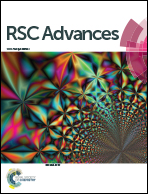Synthesis of flower-shaped ZrO2–C composites for adsorptive removal of trichlorophenol from aqueous solution
Abstract
In the current study, examples of a novel kind of nanoflake zirconia–carbon (ZrO2–C) composite were synthesized through a simple method by using gallic acid and ZrCl4 as precursors. The as-synthesized ZrO2–C composites were observed to have high specific surface areas and a chrysanthemum-like structure. High-resolution transmission electron microscopy, X-ray photoelectron spectroscopy, infrared spectroscopy, X-ray diffraction, and Raman analyses revealed that the ZrO2–C composites were composed of graphitized carbon and numerous ZrO2 nanoparticles (3–4 nm in diameter). The ZrO2–C composites were successfully used as adsorption materials to remove 2,4,6-trichlorophenol (TCP) from simulated water samples. The results showed that ZrO2–C exhibited a much higher adsorption capacity for TCP than did some reported carbon materials. The hydrophobic interaction and/or π–π stacking interaction between TCP and the carbon phase, hydrogen bonding with functional groups of ZrO2–C, and metal–anion binding with ZrO2 nanoparticles contributed to the high adsorption ability. Generally, TCP uptake was favorable in an acidic environment and increased as the initial TCP concentration and temperature were increased. The adsorption process obeyed pseudo-second-order kinetics, and the adsorption isotherms could be well described by the Freundlich equation.


 Please wait while we load your content...
Please wait while we load your content...